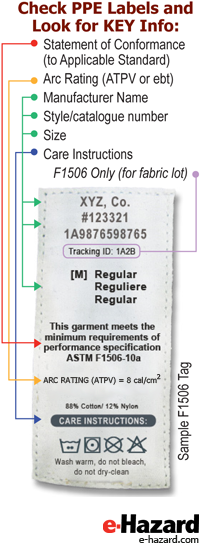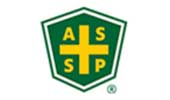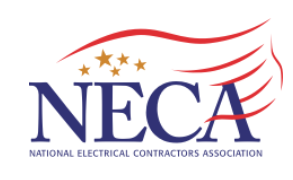Look for the Arc Rating Label
Author: Hugh Hoagland
Remember the jingle “Look for the union label” from the International Ladies’ Garment Workers’ Union campaign in the ’80s? It’s a good reminder today when buying PPE. OSHA, NFPA 70E and ANSI C2 (NESC) all agree: you should look for the AR (Arc Rating) label when buying a shirt or a suit. Most of the industry turns to the national consensus standards such as ANSI/IEEE’s National Electrical Safety Code (NESC) or NFPA 70E Standard for Electrical Safety in the Workplace.
These two standards cover electric utility work and other general industry electrical work, respectively. NFPA 70E began to “reframe” the terminology to get people to ask for AR rather than FR (flame resistant) clothing in 2012. The reason for this change is that FR doesn’t have any standards which apply to any particular hazard. FR traditionally was believed to be generically protective from flame at some level but this is actually untrue of some fabrics. There are two problems:
Minimum standards
When we set minimum standards, technology starts finding ways to “pass the test” which the test creators (the standards committee) did not envision. Sometimes these technological changes are helpful, but other times they are detrimental to the protection.
Small Scale Testing
Small scale tests are developed to replicate a part of the hazard in an inexpensive way, to allow for cost effective testing, but when only a small scale test is used, there may not be a way to differentiate between good and bad fabrics without a battery of tests or a “large scale test.”
In arc rating, unlike FR, we have a large scale test which can be matched to protection levels. AR is a protection level which closely correlates with protection in the real world. So in your “reframing,” start using the term “arc-rated (AR)” vs. “flame resistant (FR)” clothing or “Arc Rated, Flame Resistant clothing.” Either term is correct and will have true meaning.
In the flash fire world we should start talking about Flash-Fire Rated (FFR) clothing which meets a flash fire standard (such as NFPA 2112 or for rainwear use ASTM F2733), electric arc hazard clothing which meets an arc standard (such as ASTM F1506, ASTM F1891 for rainwear or ASTM F2178 for hoods, goggles and faceshields) and firefighter clothing which meets a firefighter standard (such as NFPA 1971 Turnout Gear, NFPA 1975 Fire Station-wear or NFPA 1977 Wildland Firefighting). This is clear, and the labeling is helpful to choose the FR clothing based on its hazard, such as AR or FFR.
Watch for deceptive companies using standards like D6413 (no pass/fail criteria), FTMS 191A.5901 or FTMS 191A.5903 (old standards no longer published or updated). NFPA recently provided a clear statement against misusing NFPA 701 in garments. This standard is only for wall coverings, curtains, furniture, and other building uses. It does not apply to garments and doing so is a misuse of the standard which opens a company that’s labeling garments “Flame Resistant per NFPA 701” to liability.
Match the Standard to your Hazard and Check the Label!
Applicable Standards |
||
|---|---|---|
| ASTM | F1506 -10a | Flame Resistant and Arc Rated Textiles for Wearing Apparel for Use by Electrical Workers |
| F1891-12 | Arc and Flame Resistant Rainwear | |
Additional Standards Related to Fire Hazards |
||
|---|---|---|
| ASTM | F2733-09 | Flame Resistant Rainwear |
| NFPA | 2112-12 | Flame-Resistant Garments for Protection of Industrial Personnel Against Flash Fire |
DO NOT Use Obsolete, Non-Applicable Standards |
||||
|---|---|---|---|---|
| FTMS | 191A.5901 | NFPA | 701 (Curtains,etc.) | |
| 191A.5903 | D6413 (Test Method) | |||

Do You Need Electrical Safety Training?
Join thousands of happy customers who have gone through our training.





